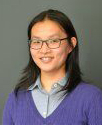In Silico Prediction of Effective Drug Regimens
Using validated computational models to identify new targets and score combination therapies for clinical efficacy against tuberculosis and other diseases
Technology Overview
 Dr. Shuyi MaTuberculosis, caused by the bacterium Mycobacterium tuberculosis (MTB), kills 2 million people each year. Currently, treatment requires multiple antibiotics taken for at least 6 months, and resistance is rising. Dr. Ma applies a rational, data-driven approach to identify new drug targets and drug regimen design strategies for treating tuberculosis.
Dr. Shuyi MaTuberculosis, caused by the bacterium Mycobacterium tuberculosis (MTB), kills 2 million people each year. Currently, treatment requires multiple antibiotics taken for at least 6 months, and resistance is rising. Dr. Ma applies a rational, data-driven approach to identify new drug targets and drug regimen design strategies for treating tuberculosis.
Dr. Ma created and validated an in silico-guided platform for designing multidrug regimens for tuberculosis. Her work builds on INDIGO (inferring drug interactions using chemogenomics and orthology), an artificial intelligence method developed by her collaborators to predict drugs that act synergistically or antagonistically, based on growth data from bacteria exposed to drug combinations. This approach and the MTB extension created by Dr. Ma can be applied to drugs even when their targets or mechanisms of action are unknown.
INDIGO-MTB extends the INDIGO technology to identify efficacious drug combinations using transcriptomic data measured from monotherapy. In a proof-of-concept study, Dr. Ma and collaborators used data on known drug interactions to build a computational model that predicts synergistic or antagonistic interactions of combinations featuring 2 or more drugs. During model building, a collection of transcriptome response profiles elicited by individual drugs at a single dose is matched to interaction phenotypes elicited by the corresponding pairwise drug combinations. The model extracts signatures of expression changes that correlate with synergy and antagonism. Once built, the model predicts interactions in regimens of 2 or more drugs by applying the identified signatures to input transcriptome data. This modularity allows Dr. Ma to generate predictions about combinations that include new drugs, simply by collecting transcriptomes about them. Transcriptomes do not need to be collected for drug pairs, so the experimental cost to generate predictions for new drugs is greatly reduced.
Experimental validation showed that INDIGO-MTB accurately identifies and quantifies interactions between 2 or 3 drugs in vitro—and provides the genes that underlie them. In addition, via meta-analysis of clinical trials for tuberculosis treatments, Dr. Ma's group showed that INDIGO-MTB predictions of combinations featuring up to 5 drugs also correlated well with markers of clinical efficacy in humans.
Adding data on MTB gene regulatory networks to INDIGO-MTB identified the gene for a transcriptional regulator of multidrug interactions. The gene was confirmed experimentally to shift interactions in two drug combinations including streptomycin toward synergy when induced. These results demonstrate the utility of INDIGO-MTB for ranking the likely efficacy of new combinations of drugs for treating tuberculosis and for determining targets to enhance synergy in new therapeutic approaches.
The INDIGO-MTB technology can be adapted for other pathogens. Dr. Ma is applying the approach to Mycobacterium abscessus, which commonly infects people with cystic fibrosis. In addition, the Ma group is developing an in vivo zebrafish-based model to predict and test drug combinations for their side effects and toxicity.
Dr. Ma is interested in partnerships to further develop her in silico-guided models, for example with additional data on microenvironmental factors that influence combinatorial drug efficacy. The overall goal is a preclinical tool that scores and prioritizes drug combinations by likely efficacy and toxicity, to identify safe, effective new drugs and combination therapies for tuberculosis and other hard to treat diseases.
Stage of Development
- Preclinical in-vitro
- Preclinical in vivo
Partnering Opportunities
- Collaborative research and development
- Sponsored research agreement
Publications
- Ma S, Jaipalli S, Larkins-Ford J…Chandrasekaran S. Transcriptomic signatures predict regulators of drug synergy and clinical regimen efficacy against tuberculosis. mBio. 2019. 10(6):e02627-19.
- Chandrasekaran S, Cokol-Cakmak M, Sahin N…Cokol M. Chemogenomics and orthology-based design of antibiotic combination therapies. Mol Syst Biol. 2016. 12(5):872.
Learn More
To learn more about partnering with Seattle Children’s Research Institute on this or other projects, email the Office of Science-Industry Partnerships.
